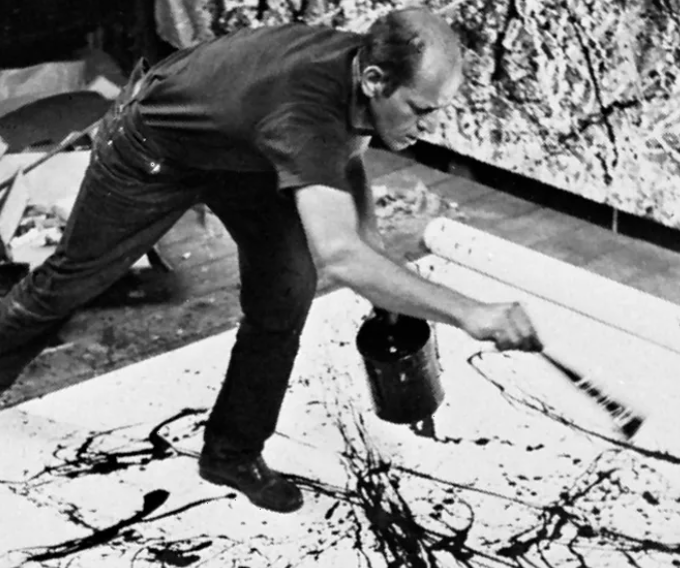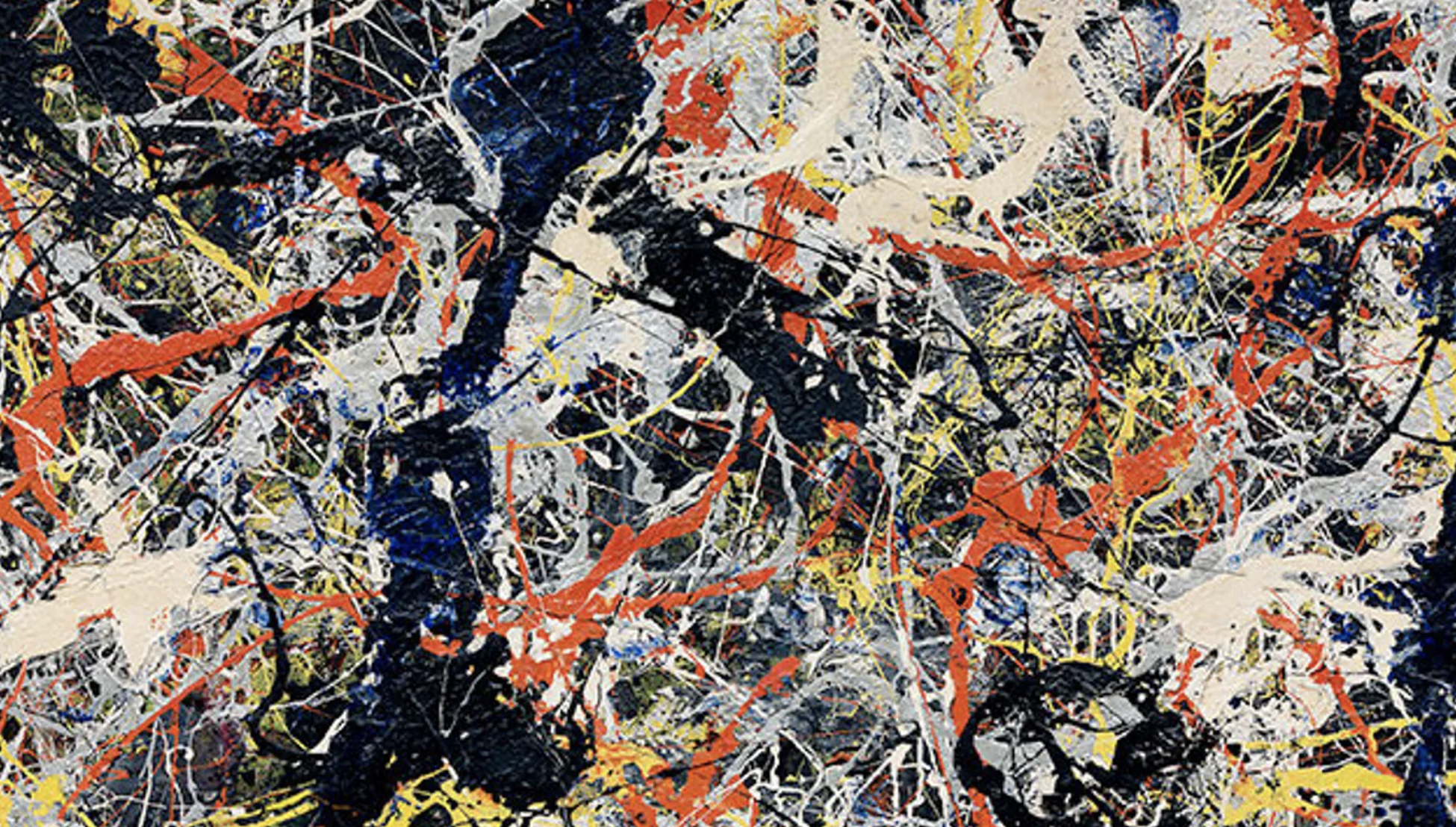The interior and the exterioR
Deleuze allows the sensual to materialise as an expressive abstraction, as he folds Pollock into his writing (2006, p. 130). Pollock’s method appears intuitive and rhythmic as the paint hits the canvas on the ground[1] (Chernick, 2020)[2]. As Pollock moves, drips and daubs paint from a height, the material folds and captures the sensual within the lines. The paint as it folds
Jackson Pollock painting in his studio on Long Island, New York, 1950. © Hans Namuth
seems to communicate Pollock's energy enabling emotions, visceral and sensual forces that are difficult to express through words to be revealed. When questioned about painting, Pollock replied, “painters do not have to go to a subject matter outside of themselves” (Chernick, 2020). He seems to create a new sensual language with no object or subject, as the folding lines form no focal point. For Deleuze, the fold is ‘actualized in the soul’ (1991, p.242), as the sensual force ‘is realized in its own way in matter’ (ibid, p.242) and flows through and from the materials. In the process of making, the material is all matter, human and non-human. From a Deleuzian perspective, Pollock’s work is a ‘folding of mind, body and world that articulates thinking itself as vibrational’ (Walton, 2016, p. 208).
Section of Jackson Pollock’s Blue Poles (1952) (Original painting 213cm x 498.5cm). © National Gallery of Australia.
Suppose the act of making is thinking, a vibration, a diffractive wave, and a continuum. If this is the case, Pollock folded through Walton and Deleuze, ‘triggers “vibrations or oscillations” that continue to resonate and harmonise in the soul/mind' (Walton, 2016, p. 208). It appears to Walton that Deleuze forms a neo-baroque fold that flows between immaterial ‘folds in the soul’ and material ‘coils of matter’ (Deleuze, 1991, p.227) as Pollock splashes paint onto canvas from a distance. The distance seems essential and allows the sensual to be transient matter, flowing between the inner and outer, upper and lower (Vidler, 2002, p. 232), from the paintbrush to the canvas. As the paint flows, the tension distributes, and the two, the paint and the sensual, meld into the same world. Here, through the works of Deleuze, Pollock and Walton, fold upon fold, matter reveals its texture and becomes shared material. On the page, or canvas, or through thread, lines hold ‘an infinite number of folds… each one determined by the consistency or the participation of its setting’ (Deleuze, 1991, p. 231). Lines are relevant to my practice as they lead to the forming of folds and knots within my knotwork. These knotworks are material and conceptual… and there is another dimension. The fluid space between the material and the thought holds the sensual.
The high and the low
Deleuze cites the Church of Sant' Agnese di Agone as an example of the grandeur of Baroque, as an allegorical house, a labyrinth of thought and a visualisation of the mind (Deleuze, 2006, p. 5). The marble facade holds the body, the church’s form, before the external folds into the interior and melds to infinity (Deleuze, 1991, p. 227). Within the church, 'the folds in the soul', the high, the immaterial (ibid., p. 227), and ‘the coils of matter', the physical material, the low, twist and turn and culminate in the form of myriad angels and saints, and the Virgin Mary, in Ciro Ferri's frescoes within the dome (Berardi et al. 2009) [3]. For Deleuze, this building is an apparatus that gives insight to the unseen yet felt.
The fresco at Sant’ Agnese di Agone painted by Ciro Ferri. Photograph Feng Wei Photography
Here the conceptual, sensual and socio-political converge, as Deleuze appears to breathe another life into Ferri's visualisation of the angels welcoming Saint Agnes into their world before they dissipate into eternity. As an onlooker left standing firmly on the earth, wondering about the destiny of imagined immortals, the material and the immaterial entangle and unfold (Deleuze, 2006, p. 39). Deleuze indicates it could be possible for us, being mere mortals standing on the ground, to feel separation from the saints in the dome. He also suggests the painted images, the celestial beings formed of pigments, evoke sensual connection within our minds.
Whether we, as onlookers, think the materials that form the pigment are 'active or passive, the derivative forces of matter refer to the primitive forces, those of the soul' (Deleuze, 1991, p. 246). It is the matter which forms the being within the painting and stimulates the sensual experience, according to Deleuze. This might imply sensual folds are found between the visible elements within the dome. However, within the sensual folds, the aural and the imagined aural experience, are invisible. If there is an invisible sensual connection between the folding of space perhaps this is the merging of the high and low within the church[4], the immortal and mortal.
For Deleuze, the imagined is ‘the two stories and their harmony’ (1991, p. 246), and possibly sound appears as a continuum, an invisible but audible wave envisioned within the ‘mental landscape’ (Deleuze, 2006, p. 40)[5]. If the imagined wave is sound from the choir of angels, abstracted and unfolded within 'the mental landscape' of the onlookers, then everything is seemingly in tune. Deleuzian harmony materialises, and the two stories merge, and a wave continuously resonates, folds and unfolds between the material and immaterial, the human and the celestial (Deleuze, 1991, p. 243), into infinity. This notion of seeking a space where the sound and the imagined evoke the sensual within a virtual apparatus is perhaps what I have been trying to do within the films, 31/10/2012-21 (2021), Slippage (2021) and Moor Slippage (2021). I intend to develop this thought by making sound pieces within this research.
[1] In his lecture, The Dramaturgy of Soul, speaking about Tintoretto’s Final Judgement, Deleuze suggests, ‘The ground is that from which all the grounds emerge, the fore ground and back ground, and that determines in each case the relation of the fore ground to back ground‘ (1987a).
[2] Jackson Pollock: Blue poles. https://www.youtube.com/watch?v=GMgz-p0jjBI A documentary with original footage of Jackson Pollock working and speaking about his practice.
[3] Berardi, U., Cirillo, E. and Martellotta, F. (2009) speaks of the acoustic energy within the dome.
[4] This in-between space, or series of folds, seems to parallel the space between Pollock's hand holding the paintbrush and the canvas on the ground.
[5] Deleuze (2006, p.40) the reference of 'mental landscape' is multi-dimensional, perhaps it is the landscape the folds of the brain, or a landscape with regards to how we think and form thoughts. Alternatively, the landscape could be mental and have a mind of its own. If the landscape is thinking, the matter as material has agency and folds into Bennett and Alaimo's scholarship. A 'mental landscape' could bring to the forefront the notion of the subject and dualist thinking and control.


